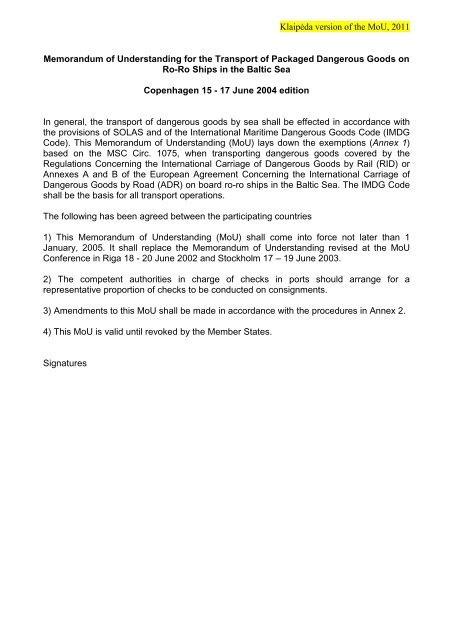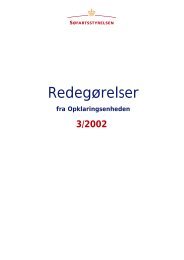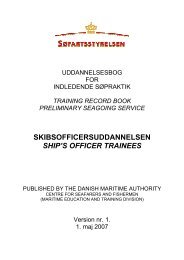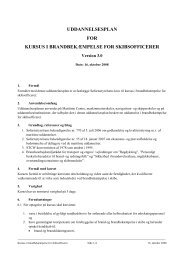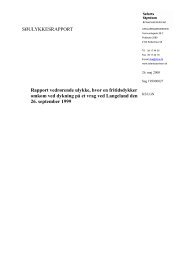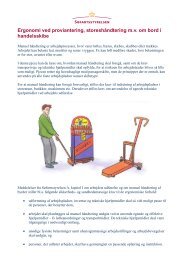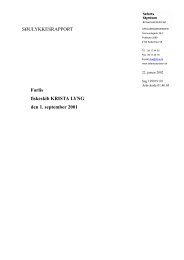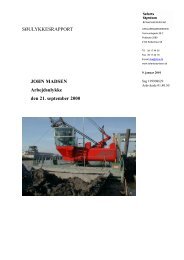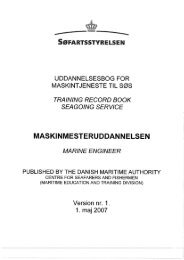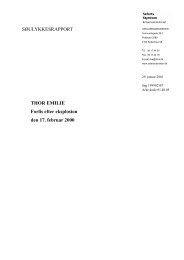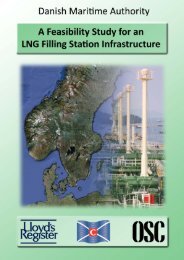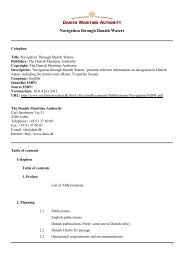MEMORANDUM OF UNDERSTANDING
MEMORANDUM OF UNDERSTANDING
MEMORANDUM OF UNDERSTANDING
You also want an ePaper? Increase the reach of your titles
YUMPU automatically turns print PDFs into web optimized ePapers that Google loves.
Klaipėda version of the MoU, 2011<br />
Memorandum of Understanding for the Transport of Packaged Dangerous Goods on<br />
Ro-Ro Ships in the Baltic Sea<br />
Copenhagen 15 - 17 June 2004 edition<br />
In general, the transport of dangerous goods by sea shall be effected in accordance with<br />
the provisions of SOLAS and of the International Maritime Dangerous Goods Code (IMDG<br />
Code). This Memorandum of Understanding (MoU) lays down the exemptions (Annex 1)<br />
based on the MSC Circ. 1075, when transporting dangerous goods covered by the<br />
Regulations Concerning the International Carriage of Dangerous Goods by Rail (RID) or<br />
Annexes A and B of the European Agreement Concerning the International Carriage of<br />
Dangerous Goods by Road (ADR) on board ro-ro ships in the Baltic Sea. The IMDG Code<br />
shall be the basis for all transport operations.<br />
The following has been agreed between the participating countries<br />
1) This Memorandum of Understanding (MoU) shall come into force not later than 1<br />
January, 2005. It shall replace the Memorandum of Understanding revised at the MoU<br />
Conference in Riga 18 - 20 June 2002 and Stockholm 17 – 19 June 2003.<br />
2) The competent authorities in charge of checks in ports should arrange for a<br />
representative proportion of checks to be conducted on consignments.<br />
3) Amendments to this MoU shall be made in accordance with the procedures in Annex 2.<br />
4) This MoU is valid until revoked by the Member States.<br />
Signatures
Annex 1<br />
as amended in Klaipėda<br />
8-9 September 2011<br />
Memorandum of Understanding for the Transport of Packaged Dangerous Goods in the Baltic Sea<br />
Section 1<br />
Application<br />
(1) By derogation from the provisions of the IMDG Code, these provisions may be applied on all ro-ro ships<br />
operating within the Baltic Sea proper, the Gulf of Bothnia, the Gulf of Finland and the entrance to the Baltic<br />
Sea bounded in the north by the line Skaw-Lysekil provided that the requirements following below are met.<br />
(2) Ro-ro ships having been issued with a Document of Compliance in accordance with Section 8 below may<br />
carry, at the same time, cargo transport units (CTUs) which either fulfil the requirements of RID/ADR or of<br />
the IMDG Code.<br />
(3) Dangerous goods, which either fulfil the requirements of the IMDG Code or RID or ADR may be loaded<br />
together in the same CTU (see Section 4).<br />
Section 2<br />
Definitions<br />
(1) The terms used in this MoU refer to the IMDG Code except those listed below in this section<br />
(2) Shipowner means company as defined in the ISM Code.<br />
(3) On-deck stowage means stowage on the weather deck.<br />
(4) Under-deck stowage means stowage in a cargo space; in an open ro-ro cargo space, unless it is<br />
considered by a competent authority to be a weather deck; and/or in a closed ro-ro cargo space, as<br />
appropriate.<br />
(5) Low Wave Height Area (LWHA) is a sea area where according to the Agreement concerning specific<br />
stability requirements for ro-ro passenger ships undertaking regular scheduled international voyages<br />
between or to or from designated ports in North West Europe and the Baltic Sea, 28 February 1996<br />
(Stockholm Agreement), set into effect on 1 April 1997, the significant wave height does not exceed 2.3<br />
metres more than 10 % of the year (see Appendix 1 of Annex 1). Traffic in other areas can be considered as<br />
LWHA traffic by the competent authorities concerned if equivalent safety can be assured.<br />
(6) The competent authorities in accordance with these provisions are:<br />
Denmark Danish Maritime Authority<br />
Vermundsgade 38 c<br />
DK-2100 COPENHAGEN O<br />
E-mail: info@dma.dk<br />
Estonia Estonian Maritime Administration<br />
Maritime Safety Division<br />
Valge 4<br />
EE-11413 Tallinn<br />
E-mail: mot@vta.ee<br />
Finland Finnish Transport Safety Agency<br />
P.O. Box 320<br />
FI-00101 HELSINKI<br />
E-mail: kirjaamo@trafi.fi<br />
2
Germany Federal Ministry of Transport, Building and Urban Affairs<br />
P.O. Box 20 01 00<br />
D-53170 BONN<br />
E-mail: Ref-UI33@bmvbs.bund.de<br />
Lithuania Lithuanian Maritime Safety Administration<br />
J. Janonio str. 24<br />
LT-92251 KLAIPEDA<br />
E-mail: msa@msa.lt<br />
Latvia Maritime Administration of Latvia<br />
5 Trijádibas str.<br />
LV-1048 RIGA<br />
E-mail: lja@lja.lv<br />
Poland Ministry of Infrastructure<br />
Ul. Chalubinskiego 4/6<br />
PL-00928 WARSAW<br />
E-mail: info@mi.gov.pl<br />
Sweden Swedish Transport Agency<br />
Box 653<br />
SE-601 15 NORRKÖPING<br />
E-mail: kontakt@transportstyrelsen.se<br />
Section 3<br />
Transport of dangerous goods<br />
(1) Dangerous goods that are classified, packaged, marked, labelled, documented and loaded together on or<br />
in a CTU or unit load in accordance with the requirements of RID, ADR or the IMDG Code may be<br />
transported in accordance with the provisions of this MoU.<br />
(2) The application of packing instruction R001 or section 4.1.4 of ADR or RID is allowed only for the traffic in<br />
LWHA.<br />
(3) Tanks shall either comply with chapter 4.2 ADR/RID/IMDG Code, as amended, or comply with chapter<br />
4.3 ADR/RID, as amended. Tanks with open venting devices should not be permitted for transport on board<br />
of ro-ro ships.<br />
(4) Bulk containers shall comply with chapter 7.3 ADR/RID, as amended, or 4.3 of the IMDG Code, as<br />
amended. For substances of class 4.3 only closed CTUs shall be used.<br />
(5) Vehicles (UN 3166 or 3171) loaded in a closed or sheeted CTU may be carried provided that the<br />
consignor or his representative informs the master about the presence of the vehicle.<br />
Section 4<br />
Loading and placarding of CTUs<br />
(1) Packages (packagings, large packagings or IBCs) containing dangerous goods shall be segregated from<br />
each other within CTUs in accordance with the provisions of the IMDG Code. For traffic in LWHA packages<br />
with segregation categories 1 and 2 of table 7.2.1.16 of the IMDG Code may be loaded together in the same<br />
CTU. Paragraph 7.5.2.2 Note a of RID/ADR may be used for traffic in LWHA.<br />
(2) Substances and articles assigned to class 1 or bearing a label of class 1 as subsidiary risk, shall be<br />
loaded and segregated in accordance with ADR/RID or the IMDG Code.<br />
(3) Placarding and marking of CTUs containing dangerous goods shall be in accordance with the provisions<br />
of the IMDG Code or RID/ADR, see Section 5.<br />
CTUs containing Marine Pollutants have to be marked according to the IMDG Code, if they are not marked<br />
according to section 5.3.6 of RID/ADR.<br />
3
Section 5<br />
Transport of CTUs<br />
CTUs containing dangerous goods may be carried on ro-ro ships in accordance with the following provisions:<br />
(1) A container/vehicle packing certificate (CTU packing certificate) shall be issued for each CTU containing<br />
dangerous goods. The model CTU packing certificate shall comply with the IMO/ILO/UN ECE Guidelines 1<br />
for<br />
packing of Cargo Transport Units (CTUs) referred to in Section 9 (2). For mixed loading for traffic in LWHA,<br />
the packing certificate shall state that any prohibition of mixed loading as specified in Section 4 (1) sentence<br />
2, has been complied with. In that case the following has to be stated in the packing certificate: “Packed<br />
together according to the MoU”.<br />
(2) When dangerous goods are transported in accordance with chapter 3.4 and/or 3.5 of RID or ADR the<br />
consignor or his representative shall provide the master with the following information: “Dangerous goods in<br />
limited and/or in excepted quantities of class(es)...“.<br />
When dangerous goods are transported in accordance with paragraphs 1.1.3.1 (b) – (f) or 1.1.3.2 (a) – (c) or<br />
(e) or 1.1.3.4.1 of RID /ADR, unless exempted by the IMDG Code, the consignor or his representative shall<br />
inform the master that these paragraphs are used.<br />
(3) CTUs as referred to in 1.1.3.4.2 RID/ADR and 1.1.3.6 ADR shall display on two opposite sides a neutral<br />
orange-coloured plate from the time they have been checked in at the port facility and during the voyage ,<br />
unless they are marked according to chapter 3.4 RID/ADR. The responsibility for fitting such plates shall rest<br />
with the person actually placing the CTU ready for loading on board the ro-ro ship.<br />
(4) When the placarding and marking of trailers without a motor vehicle is not in accordance with the<br />
provisions of the IMDG Code, the trailers shall display, on two opposite sides a neutral orange-coloured<br />
plate, from the time they have been checked in at the port facility and during the voyage. The responsibility<br />
for fitting such plates shall rest with the person actually placing the trailer ready for loading on board the ro-ro<br />
ship.<br />
(5) Orange-coloured plates mentioned in 5 (3) and 5 (4) means plates conforming to RID/ADR 5.3.2.<br />
Plates required only in the MoU shall be clearly visible and conform to RID/ADR 5.3.2.2.1 regarding size and<br />
colour. These plates may be replaced by self-adhesive sheets, by paint or by any other equivalent process.<br />
Section 6<br />
Stowage and segregation between CTUs<br />
(1) Segregation between CTUs shall be in accordance with the provisions of the IMDG Code, except that for<br />
LWHA traffic no separation is required for segregation categories 1 and 2 in table 7.2.4.2 of the IMDG Code.<br />
(2) Stowage and segregation of class 1 shall be in accordance with the IMDG Code and the Document of<br />
Compliance (SOLAS 1974, II-2/19).<br />
1 See IMDG Code, 5.4.2 and Supplement, 4.4.2.<br />
4
(3) The following table shall apply to the stowage of CTU containing dangerous goods:<br />
Stowage table for CTUs containing packaged dangerous goods of classes 2 to 9<br />
Note: Stowage shall also be in accordance with the Document of Compliance (SOLAS 1974, II-2/19) or<br />
the Letter of Compliance referred to in Section 8 of the MoU.<br />
Description and class as specified in<br />
IMDG Code/RID/ADR<br />
Gases<br />
Cargo ships<br />
or passenger ships carrying either not<br />
more than<br />
25 passengers or<br />
1 passenger per 3 metres of overall<br />
length *)<br />
Other passenger ships<br />
Description Class<br />
2<br />
On deck Under deck On deck Under deck<br />
-flammable gases.<br />
-non-flammable non-toxic<br />
gases.<br />
-toxic gases<br />
Flammable liquids<br />
- packing group I or II<br />
- packing group III<br />
Flammable solids<br />
- UN No.1944, 1945, 2254,<br />
2623<br />
- other UN numbers<br />
Substances liable to<br />
spontaneous combustion<br />
2.1<br />
2.2<br />
2.3<br />
3<br />
4.1 2)<br />
Permitted<br />
Permitted<br />
Permitted<br />
Permitted<br />
Permitted<br />
Permitted<br />
Permitted<br />
Prohibited<br />
Permitted 3)<br />
Prohibited<br />
Permitted<br />
Permitted<br />
Permitted<br />
Prohibited<br />
Prohibited<br />
Permitted 3)<br />
Prohibited<br />
Permitted<br />
Permitted<br />
Permitted<br />
Permitted<br />
Prohibited<br />
Permitted 3)<br />
Prohibited<br />
Prohibited<br />
Permitted<br />
Permitted<br />
Prohibited<br />
4.2 Permitted Prohibited Permitted Prohibited<br />
Substances which give off<br />
flammable gases in contact<br />
with water<br />
4.3 Permitted 1) Prohibited Permitted 1) Prohibited<br />
Oxidizing substances 5.1 Permitted Permitted Permitted Prohibited<br />
Organic peroxides 5.2 2) Permitted Prohibited Prohibited Prohibited<br />
Toxic substances<br />
6.1<br />
- packing group I or II<br />
Permitted Prohibited Permitted Prohibited<br />
- packing group III<br />
Permitted Permitted Permitted Permitted<br />
Infectious substances 6.2 Permitted Permitted Prohibited Prohibited<br />
Radioactive material 7 Permitted Permitted Permitted Permitted<br />
Corrosive substances<br />
8<br />
- packing group I or II<br />
- liquids packing group III<br />
- solids packing group III<br />
Miscellaneous dangerous<br />
substances and articles<br />
Permitted<br />
Permitted<br />
Permitted<br />
Prohibited<br />
Permitted<br />
Permitted<br />
Prohibited<br />
Permitted<br />
Permitted<br />
Prohibited<br />
Prohibited<br />
Permitted<br />
9 Permitted Permitted Permitted Permitted<br />
1) The carriage of Aluminium ferrosilicon powder of UN number 1395, Aluminium silicon powder, uncoated of UN number 1398,<br />
Calcium silicide of UN number 1405 and Ferrosilicon of UN number 1408 when transported in bulk packagings, in containers, road<br />
vehicles or rail wagons, tank containers or demountable tanks is allowed only when accompanied by a certificate stating that the<br />
material was stored under cover, but in the open air, and that the particle size is representative of the material stored.<br />
2) For the stowage of these substances, chapter 7.7 of the IMDG Code shall be complied with in addition to the provisions of ADR.<br />
3) Refrigerated gases of ADR or of stowage category “D” of the IMDG Code are prohibited.<br />
*) For the purpose of the MoU the total number of passengers may be extended to not more than 1 person per 1 metre of the overall<br />
length of the ship.<br />
Notes pertaining to this table:<br />
A: If the stowage of dangerous goods is prohibited according to this table for one item contained in a CTU<br />
loaded with mixed dangerous goods, this prohibition applies to the whole unit within that compartment.<br />
5
B: Substances assigned to special provisions SP 349, 350, 351, 352, 353 or 900 of the IMDG Code are<br />
prohibited.<br />
C: If the stowage of dangerous goods is prohibited according to or not covered by this table, but is permitted<br />
under the provisions of the IMDG Code, the stowage requirements of the IMDG Code may be applied<br />
instead.<br />
Section 7<br />
Additional duties for the consignors<br />
(1) The consignor shall ensure that, in addition to the information required by the provisions of RID/ADR, the<br />
dangerous goods are identified within the documentation as „MARINE POLLUTANT“, if applicable.<br />
(2) If liquid dangerous goods to be transported having a flashpoint of 60°C or below (closed cup (c.c.)), the<br />
flashpoint range in accordance with the relevant packing group should be indicated. For substances to be<br />
transported under UN No 1133, 1139, 1169, 1197, 1210, 1263, 1266, 1286, 1287, 1306, 1866, 1993 or 1999<br />
it shall be indicated if the flashpoint is below 23°C and cargo shall be stowed accordingly.<br />
Section 8<br />
Requirements applicable to ships<br />
(1) Ships shall, with regard to design and equipment, fulfil the requirements of regulation II-2/54 of SOLAS<br />
74, as amended. For ships constructed on or after 1 July 2002 regulation II-2/19 SOLAS 74, as amended,<br />
shall be applicable. The Document of Compliance shall include information specifying the classes of<br />
dangerous goods, which may be stowed in the individual cargo spaces of the ship.<br />
(2) Ships constructed before 1 September 1984 already provided with a letter of compliance may continue to<br />
transport dangerous goods in accordance with the requirements applicable at the time, when the letter of<br />
compliance was issued. However, these ships shall comply with the requirements of chapter 7.4 of the IMDG<br />
Code.<br />
(3) A Letter of Compliance issued in accordance with the MoU is considered to be equivalent as being<br />
specified in 7.4.5.7 of the IMDG Code.<br />
Section 9<br />
Additional requirements<br />
(1) During the voyage, CTUs containing dangerous goods shall be secured in compliance with the Cargo<br />
Securing Manual approved by the Administration. As far as practicable, IMO Resolution A.581(14) of 20<br />
November 1985 shall be observed. CTUs without facilities for lashing may not be offered for transport under<br />
the provisions of this MoU.<br />
(2) The IMO/ILO/UN ECE Guidelines for Packing of Cargo Transport Units (CTUs) shall be observed for all<br />
cargo transport units.<br />
(3) Ro-ro vessels shall have on board current versions of:<br />
a) the International Maritime Dangerous Goods Code (IMDG Code);<br />
b) the Emergency Procedures for Ships Carrying Dangerous Goods (EmS);<br />
c) the Medical First Aid Guide for Use in Accidents Involving Dangerous Goods (MFAG);<br />
d) the applicable Regulations Concerning the International Carriage of Dangerous Goods by Rail (RID)<br />
or Annexes A and B of the European Agreement Concerning the International Carriage of Dangerous<br />
Goods by Road (ADR), as appropriate to the mode of transport.<br />
(4) Shipowners shall ensure that the persons they appoint and who are involved in the transport of CTUs<br />
under the provisions of the present MoU are made familiar, through repeated training, with the application of<br />
the relevant provisions, in particular, with those of ADR or RID. They shall ensure that the persons involved<br />
will be issued with a certificate stating that they have been trained and informed accordingly.<br />
6
(5)The competent authorities concerned may grant exemptions for a period of not more than 1 year,<br />
provided an equivalent level of safety is maintained. The MoU Member States shall be notified of such<br />
exemptions.<br />
(6) The competent authorities as listed in Section 2 above should arrange for a representative proportion of<br />
checks to be conducted on consignments using a checklist (Appendix 2).<br />
(7) The number and results of checks shall be presented at the MoU meetings and circulated to the<br />
competent authorities concerned.<br />
Section 10<br />
Transitional Regulations<br />
On board cargo ships and passenger ships carrying not more than 1 passenger per 1 meter length of the<br />
ship, CTUs may be stowed under deck by using the approval of the competent authority having granted such<br />
a stowage until 31 December 2002. Segregation of the CTUs in this deck must be performed in compliance<br />
with the requirements in the IMDG Code, section 7.2.4.2 (Table of segregation of cargo units on board ro-ro<br />
ships).<br />
Section 11<br />
Entry into force<br />
(1) This amendment to the Memorandum of Understanding shall come into force not later than 1 January<br />
2012.<br />
(2) The German and English versions of this amendment to the Memorandum of Understanding shall be<br />
equally authoritative.<br />
7
Appendix 1 of Annex 1 of the MoU<br />
8
Appendix 2 of Annex 1 of the MoU<br />
Part 1 to 4:<br />
(1) Competent authorities<br />
(2) Checklist for (MoU dangerous goods) transport<br />
(3) Checklist for deficiency (MoU dangerous goods) transport<br />
(4) Report of competent authorities<br />
Appendix 2 of the MoU<br />
Guidelines for joint checks according to section 9 (6) in the Memorandum of Understanding for<br />
the transport of dangerous goods in ro-ro ships in the Baltic Sea (MoU)<br />
1. Purpose<br />
To ensure safe international transport of dangerous goods in connection with ro-ro transport, and to<br />
coordinate joint checks carried out in ports within the area covered by the MoU.<br />
2. Application/Scope<br />
2.1 This guideline is applicable to the participating countries’ competent authorities (listed in Part (1)<br />
performing joint checks on transport of dangerous goods.<br />
2.2 Joint checks on dangerous goods should be performed in accordance with the checklist for road<br />
transport (Part 2) under the provisions of Directive 95/50/EC as amended by Directive 2004/112/EC<br />
or with the checklist for transport of dangerous goods in ro-ro ships in the Baltic (Part 3).<br />
3. Definitions<br />
3.1 Joint checks are checks, which are agreed upon by the Member States with connecting ship routes.<br />
Joint checks concerns export traffic only.<br />
3.2 Competent authority: any national authority related to check of dangerous goods.<br />
4. Procedures of joint checks<br />
4.1 Each Member State should perform four joint checks annually.<br />
4.2 Member States should exchange plans for joint checks annually on December 1 st at the latest. Plans<br />
should be submitted between Member States with connecting ship routes and the authorities should<br />
agree to a mutual timetable for joint checks for one year at a time.<br />
4.3 The execution of the joint checks should be coordinated between the competent authorities of<br />
Member States with connecting ship routes.<br />
4.4 Joint checks should, in general, be unannounced.<br />
4.5 Joint checks should be performed on basis of checklists for road transport and/or sea transport. (Part<br />
2/3)<br />
4.6. Coordination should ensure that the same transport unit is only checked by one competent authority<br />
on any joint check.<br />
4.7 Competent authorities within the MoU can participate in joint checks as observers in any check<br />
performed by other Member States.<br />
4.8 At the end of each joint check, the competent authority submits a report containing information as<br />
stipulated in Part 4, which is in accordance with the MSC/Circ. 859, to the responsible Administration<br />
appointed by MoU conference.<br />
4.9 The responsible administration submits an annual report of the joint checks to the MoU conference<br />
and IMO, on behalf of the Member States.<br />
4.10 The report should be evaluated at the MoU conference and action should be taken as appropriate.<br />
5. Others<br />
5.1 Member States, which do not follow this guideline, have to secure a safe international transport of<br />
dangerous goods on equivalent base. They inform the responsible administration (4.8) about their<br />
activities.<br />
5.2 Joint checks should be performed in accordance with the requirements of Chapter XI-2 of SOLAS in<br />
conjunction with the International Ship and Port Facility Security (ISPS) Code.<br />
9
Denmark<br />
Inspection of transports of dangerous goods on board<br />
Danish ships and on board all ships in Danish ports.<br />
Danish Maritime Authority<br />
Centre for Ships<br />
Vermundsgade 38C<br />
DK-2100 Copenhagen Ø<br />
Tel.: +45 3917 4400<br />
Tel.: +45 3917 4699 (Outside of office hours)<br />
Fax: +45 3917 4401<br />
E-mail: csa@dma.dk<br />
Arne Thykjær, tel. +45 3917 4483<br />
E-mail: atc@dma.dk<br />
Dangerous Goods by Rail (RID)<br />
Legislation and co-ordination:<br />
National Rail Authority<br />
Adelgade 13<br />
DK-1304 Copenhagen K<br />
Tel.: +45 7226 7000<br />
Fax: +45 7226 7070<br />
E-mail: info@trafikstyrelsen.dk<br />
Steen Riis Thomsen, tel. +45 7226 7061<br />
E-mail: srt@trafikstyrelsen.dk<br />
Estonia<br />
Mr Jaak Arro<br />
Head of Dangerous Goods Section<br />
Ship Control Department<br />
Estonian Maritime Administration<br />
Valge 4<br />
11413 Tallinn<br />
ESTONIA<br />
Tel.: +372 620 5715<br />
Fax: +372 620 5706<br />
E-mail: jaak.arro@vta.ee<br />
Finland<br />
Finnish Transport Safety Agency<br />
Marine Technology Department<br />
Marine Environment Protection Unit<br />
Dr. Jyrki Vähätalo<br />
P.O. Box 320<br />
FI-00101 Helsinki<br />
Tel: +358 204 618 6470<br />
E-mail: jyrki.vahatalo@trafi.fi<br />
COMPETENT AUTHORITIES<br />
Part 1 of Appendix of Annex 1<br />
Regulations pertaining to carriage of dangerous<br />
goods in packaged form by sea.<br />
Danish Maritime Authority<br />
Centre for Maritime Regulation<br />
Vermundsgade 38 C<br />
DK-2100 København<br />
Tel.: +45 3917 4400<br />
Fax: +45 3917 4401<br />
E-mail: cmr@dma.dk<br />
Steen Nielsen, tel. +45 3917 4591<br />
E-mail: sn@dma.dk<br />
Dangerous Goods by Road (ADR)<br />
Land based controls and legal proceedings:<br />
National Commission of the Danish Police<br />
Traffic Police<br />
Ellebjergvej 52,2<br />
DK-2450 Copenhagen SV<br />
Tel.: +45 33 910 910<br />
Fax: +45 3343 0159<br />
E-mail: rpchi-tvs@politi.dk<br />
Torkil Hansen, tel. +45 2275 2599<br />
E-mail: tkh002@politi.dk<br />
Freddy Agerskov, tlf. +45 2555 1120<br />
E-mail: fpa001@politi.dk<br />
10
Finnish Transport Safety Agency<br />
Inspections Department<br />
Southern Inspection Unit<br />
Captain Dan Stenbäck<br />
P.O. Box 320<br />
FI-00101 Helsinki<br />
Tel. +358 20 618 6462<br />
Fax +358 20 618 6596<br />
E-mail: dan.stenback@trafi.fi<br />
Finnish Transport Safety Agency<br />
Inspections Department<br />
Western Inspection Unit<br />
Mr Seppo Nousiainen<br />
P.O. Box 209<br />
FI-20101 Turku<br />
Tel.: +358 20 618 6605<br />
Fax: + 358 20 618 6619<br />
E-mail: seppo.nousiainen@trafi.fi<br />
Finnish Transport Safety Agency<br />
Inspections Department<br />
Northern Inspection Unit<br />
Mr. Tomas Lindström<br />
P.O. Box 31<br />
FI-65101 Vaasa<br />
Tel: +358 20 618 6674<br />
Fax: +358 20 618 6679<br />
E-mail tomas.lindstrom@trafi.fi<br />
Germany Mecklenburg-Pommerania<br />
Innenministerium Mecklenburg-Vorpommern<br />
Referat Einsatz/Lagezentrum<br />
Alexandrinenstraße 1<br />
19055 Schwerin<br />
Tel: +49 385/588 2439<br />
Fax: +49 385/588 2480<br />
E-mail: nils.wenzek@im.mv-regierung.de<br />
Ministerium für Verkehr, Bau und Landesentwicklung<br />
Mecklenburg-Vorpommern<br />
Referat 210<br />
Schloßstraße 6 - 8<br />
19053 Schwerin<br />
Tel.: +49 385/588 8217<br />
Fax: +49 385/588 8278<br />
E-mail: monika.blumberg@vm.mv-regierung.de<br />
Landeswasserschutzpolizeiamt<br />
Mecklenburg-Vorpommern<br />
Gefährliche Güter/Umweltschutz<br />
Hohen Tannen 10<br />
18196 Waldeck<br />
Tel.: +49 38208/887 3164<br />
Fax: +49 38208/887 3116<br />
E-mail: gefahrgut@lwspa-mv.de<br />
Finnish Transport Safety Agency<br />
Inspections Department<br />
Eastern Inspection Unit<br />
Kotka office<br />
Captain Ilpo Ruokonen<br />
P.O. Box 36<br />
FI-48101 Kotka<br />
Tel. +358 20 618 6632<br />
Fax +358 20 618 6639<br />
E-mail: ilpo.ruokonen@trafi.fi<br />
Finnish Transport Safety Agency<br />
Inspections Department<br />
Western Inspection Unit<br />
Mariehamn office<br />
Mr. Henrik Karlsson<br />
Hamngatan 4<br />
AX-22100 Mariehamn<br />
Tel: +358 20 618 6621<br />
Fax: +358 20 618 6629<br />
E-mail: henrik.karlsson@trafi.fi<br />
Finnish Transport Safety Agency<br />
Inspections Department<br />
Northern Inspection Unit<br />
Oulu office<br />
Captain Jarmo Kokko<br />
P.O. Box 58<br />
FI-90101 Oulu<br />
Tel: +358 20 618 6681<br />
Fax: +358 20 618 6689<br />
E-mail jarmo.kokko@trafi.fi<br />
11
Hansestadt Rostock<br />
Der Oberbürgermeister<br />
Hafen- und Seemannsamt Rostock<br />
Am Seehafen 2<br />
18147 Rostock<br />
Tel.: +49 381/381 8790<br />
Fax: +49 381/381 8735<br />
E-mail: port.authority@rostock.de<br />
Germany Schleswig-Holstein<br />
Innenministerium<br />
des Landes Schleswig-Holstein<br />
Herr Ralf Kock<br />
IV 426<br />
Düsternbrooker Weg 92<br />
24105 Kiel<br />
Tel.: +49 431/988 3169<br />
Fax: +49 431/988 614 3169<br />
E-mail: Ralf.Kock@im.landsh.de<br />
Polizeiliche Grundsatzangelegenheiten<br />
Landespolizeiamt Schleswig-Holstein<br />
Abteilung 4 - Wasserschutzpolizei<br />
SG 412<br />
Muhlenweg 166 / Haus 10<br />
24116 Kiel<br />
Tel.: +49 431/160 64120<br />
Fax: +49 431/160 64119<br />
E-mail: Kiel.LPA412@polizei.landsh.de<br />
Wasserschutzpolizeirevier Kiel<br />
Hafensicherheitsdienst<br />
Düsternbrooker Weg 82<br />
24105 Kiel<br />
Tel.: +49 431/160 1640/1610<br />
Fax: +49 431/160 1609<br />
Außenstelle Ostuferhafen<br />
Ostuferhafen 15<br />
24149 Kiel<br />
Tel.: + 49 431/205261<br />
Fax: +49 431/26127<br />
E-mail: kiel.wsprv@polizei.landsh.de<br />
Wasserschutzpolizeistation Puttgarden<br />
Fährhafen<br />
23769 Puttgarden<br />
Tel.: +49 4371/864 1810<br />
Fax: +49 4347/864 1819<br />
Wasserschutzpolizeirevier Lübeck-<br />
Travemünde<br />
Hafensicherheitsdienst/Zentrale Gefahrgut-<br />
Auskunftsstelle<br />
Zum Hafenplatz 1<br />
23570 Lübeck-Travemünde<br />
Tel.: +49 4502/880880<br />
Fax: +49 4502/8808819<br />
E-mail: zga.luebeck.wsr@polizei.landsh.de<br />
Stadt Sassnitz/Rügen<br />
Der Bürgermeister<br />
Hafenamt<br />
Waldmeisterstr. 6<br />
18546 Sassnitz<br />
Tel.: +49 38392/55312<br />
Fax: +49 38392/55313<br />
E-mail: hafenamt@sassnitz.de<br />
Ministerium für Wissenschaft, Wirtschaft und<br />
Verkehr des Landes Schleswig-Holstein<br />
Herr Holger Kotte<br />
VII 426<br />
Düsternbrooker Weg 94<br />
24105 Kiel<br />
Tel.: +49 431/988 4740<br />
Fax: +49 431/988 4700<br />
E-mail: holger.kotte@wimi.landsh.de<br />
Grundsatzangelegenheiten, Einzelfragen<br />
Hafen- und Seemannsamt der Landeshauptstadt Kiel<br />
Hafenkapitän Jürgen Melzer<br />
Bollhörnkai 1<br />
24103 Kiel<br />
Tel.: +49 431/901 1073<br />
Fax: +49 431/94477<br />
Lübeck Port Authority<br />
Abt. 1.691.4 Hafen- und Seemannsamt<br />
Schüsselbuden 16<br />
23552 Lübeck<br />
Tel.: +49 451/122 5918<br />
Fax: +49 451/122 5924<br />
E-mail: luebeck-port-authority@luebeck.de<br />
12
Latvia<br />
Maritime Administration of Latvia<br />
Maritime Safety Department<br />
Dangerous Cargo and Bulk Cargo Inspectorate<br />
5 Triijadibas str.<br />
LV 1048, Riga<br />
Tel.: +371 67062101<br />
Fax: +371 67860082<br />
E-mail: lja@lja.lv<br />
Lithuania<br />
Lithuanian Maritime Safety Administration<br />
J. Janonio str. 24<br />
LT-92251 Klaipeda,<br />
Director – Evaldas Zacharevičius<br />
Tel.: + 370 469 602<br />
Fax: + 370 469 600<br />
E-mail: msa@msa.lt<br />
Poland<br />
Ministry of Infrastructure<br />
Shipping Safety Department<br />
Mr Grzegorz Grządka<br />
Ul. Chałubińskiego 4/6<br />
PL-00928 WARSAW<br />
Tel. +48 22 630 18 74<br />
Fax +48 22 630 14 97<br />
E-mail: ggrzadka@mi.gov.pl<br />
Sweden<br />
Swedish Transport Agency<br />
Caroline Petrini<br />
Box 653<br />
SE-601 15 Norrköping<br />
SWEDEN<br />
Tel.: +46 10 495 3250<br />
Fax: +46 11 23 99 34<br />
E-mail: caroline.petrini@transportstyrelsen.se<br />
Swedish Coast Guard, HQ<br />
Jimmy Leijonfalk<br />
Box 536<br />
SE- 37123 KARLSKRONA<br />
SWEDEN<br />
Tel.: +46 45 5353400<br />
Mobil: +46 70 690 60 33<br />
E-mail: jimmy.leijonfalk@coastguard.se<br />
13
Part 2 of Appendix of Annex 1<br />
CHECKLIST FOR INSPECTIONS IN ACCORDANCE WITH THE MOU<br />
2. Date 3. Time<br />
1 Place of check 1.1 Terminal<br />
1.2 Harbour<br />
1.3 Company/system<br />
1.4 Theme<br />
4 Vehicle<br />
4.1 Nationality 4.2 Reg. number<br />
5<br />
trailer/semitrailer/<br />
container<br />
5.1 5.2 Reg. number. 1.5 Road<br />
6 Carrier/address<br />
Driver<br />
Driver’s assistant<br />
7<br />
Address<br />
Address<br />
8¹<br />
9¹<br />
Consignor<br />
Address<br />
Place of loading<br />
consignee Place of discharge<br />
Address<br />
10 Total quantity of dangerous good per transport unit kg<br />
11 ADR 1.1.3.6 quantity limit exceeded 11.1 yes 11.2 no Calculated value LQ EQ<br />
12<br />
Documents on<br />
booard<br />
Transport operation<br />
Equipment on<br />
board<br />
Transport with 12.1 Tank 12.2 Bulk 12.3 Package 12.2 Other<br />
Transport in<br />
accordance<br />
12.9 ADR 12.10 national road 12.11 IMDG Code 12.12 ICAO-TI<br />
12.13 RID 12.14 national rail 12.15 MoU 12.16 Other<br />
*A) Checked B) Not in acc. with the rules C) NA *A) *B) *C) Riskcategory<br />
13 13.1 DGD (5.4) 13.2 Stowage plan 13.3 CPC (5.4.2)<br />
14 Instructions in writing (ADR 5.4.3 & ADR 8.1.2.1(b))<br />
15 Bilateral Multilateral Nat.Auth<br />
16 Cert. of app. for vehicle 16.1 vehicle 16.2 ship<br />
17.1 Driver’s training certificate (ADR 8.2.1, 8.2.2)<br />
17<br />
17.2 Other dangerous goods training (1.3, ADR 8.2.3)<br />
18 Cargo authorized for transport<br />
19 19.1 vehicle/CTU 19.2 ship permitted for the cargo<br />
20 Provisions related to the mode of transport (bulk, package, tank)<br />
21 Mixed load prohibition<br />
22.1 Handling ²<br />
22 22.2 Loading/stowage²<br />
22.3 Cargo securing²<br />
23.1 Leakage²<br />
23<br />
23.2 Damage to package/vehicle²<br />
24 Approval markings packaging/tank/container<br />
25.1 Package marking (5.2.1)<br />
25<br />
25.2 Package labelling (5.2.2)<br />
26 Tank/vehicle placarding (5.3.1)<br />
27 Marking of cargo transport units (5.3.2-, ADR/RID 5.5)<br />
28<br />
General purpose safety<br />
equipment<br />
(ADR 8.1.5 a))<br />
28.1 Wheel chock<br />
28.2 Warning equipment<br />
28.3 Warning vest<br />
28.4 Handlamp(s)<br />
29 Additional equipment (ADR 8.1.5.3) Eye rinsing liquid (ADR 8.1.5.2)<br />
30<br />
31 Fire extinguisher<br />
31.1 Type A (ADR 8.1.4.1a)/8.1.4.2)<br />
31.2 Type B (ADR 8.1.4.1b), c))<br />
40 Remark<br />
s<br />
39 The most serious risk category of established infringements cat. I cat. II cat. III<br />
Authority/officer having carried out the inspection (sign)<br />
41<br />
Clarification of signature<br />
¹ To be filled only if relevant for an infringement<br />
² Check of visible violation<br />
Note
Goods<br />
Deficiency<br />
Part 3 of Appendix of Annex 1<br />
CHECKLIST DEFICIENCY IN ACCORDANCE WITH THE MoU<br />
2. Date 3. Time<br />
Pos. UN-nr. Goods description Class PG Amount Declaration<br />
nr.<br />
A<br />
B<br />
C<br />
D<br />
E<br />
F<br />
G<br />
H<br />
I<br />
J<br />
K<br />
L<br />
Nr. Goods<br />
Pos.<br />
Remarks Note<br />
LQ
1 Number of CTUs examined<br />
(with DG)<br />
2 Number of CTUs with<br />
deficiencies total<br />
3 in particular (Position in checklist)<br />
3.1 Placarding and marking (Pos. 26<br />
and 27)<br />
3.2 Labeling (of packages) (Pos. 25)<br />
3.3 Documentation (Pos. 13)<br />
3.4 Packaging (inappropriate or<br />
damaged) (Pos. 23)<br />
3.5 Portable tank or road tank<br />
vehicles (Pos. 20 and 24)<br />
3.6 Stowage/securing inside CTUs<br />
(Pos 22)<br />
3.7 Segregation of cargo (Pos. 21)<br />
3.8 Container Safety Convention (CSC)<br />
Safety Approval Plate (Pos. 40)<br />
3.9 Tie down attachments of road<br />
vehicle (Pos. 40)<br />
3.10 Other<br />
Report of the joint controls 200X<br />
Date: Submitted:<br />
Country of origin of CTU’s<br />
Part 4 of Appendix of Annex 1<br />
D Dk Est Fin Lv Lt Pol Se Other<br />
Total<br />
16
General<br />
Principles for amending the Memorandum<br />
1) The MoU may be amended at a conference or through a written procedure.<br />
Revised Annex 2 of the Memorandum<br />
2) Conferences or written procedures should be so scheduled that amendments to the international<br />
transport regulations (ADR, RID and the IMDG Code) can be taken into account.<br />
3) A conference or a written procedure should be hosted by one of the Member States.<br />
4) Each Member State or observer state/organisation may propose amendments to the MoU. The<br />
Member States should agree on the amendments by consensus.<br />
5) The revised MoU, including the agreed amendments, should be reproduced and circulated by the<br />
hosting Member State when new amendments have been adopted. The amended parts of the text should<br />
be indicated in the margin.<br />
6) The revised MoU including the new amendments shall come into force six months after the new text is<br />
available or as otherwise decided.<br />
7) Distribution and communication in general should be performed by electronic means.<br />
Conference<br />
8) Proposals should be sent to the Member State hosting the next conference at least 3 months before<br />
the conference takes place. The hosting Member State should distribute the proposals to all Member<br />
States and observer states/organizations at least 1 month before the conference. All Member States and<br />
observer states/organizations shall have the opportunity to respond to the documents presented within a<br />
period of 2 weeks after the distribution. Preferably, this distribution should be done by e-mail.<br />
9) Working groups for special issues may be arranged in the time between the conferences. The reports<br />
or proposals from such working groups should be presented at the conference in the same way as other<br />
proposals. Working groups may also take place during a conference, and this should, if possible, be<br />
notified in advance.<br />
Written procedure<br />
10) A written procedure can be used as an alternative to a conference providing this is proposed by the<br />
Member State designated to host the next conference. In such case the designated Member State will<br />
host the written procedure.<br />
11) A written procedure can also be initiated if at least 3 Member States request it. In such case the<br />
designated Member State hosting the latest conference should host the written procedure.<br />
12) The Member State hosting the written procedure shall distribute proposals and/or proposed<br />
amendments to the competent authorities in the Member States and announce the schedule for written<br />
comments. All Member States should respond to the documents presented within a period of 6 weeks. If<br />
the initial proposal is amended on the basis of comments of the Member States, the revised proposal<br />
should be distributed again to the competent authorities in the Member States. From the time when the<br />
revised proposal is distributed the Member States shall declare within 4 weeks whether they agree to the<br />
amended text of the MoU.<br />
13) The amendments are adopted if supported by all Member States. The Member State hosting the<br />
written procedure shall notify the adoption of the amendments and reproduce and circulate the revised<br />
MoU in accordance with section 5.<br />
17
14) In such case all Member States shall sign and return to the host State a hard copy of the agreed<br />
amendment. The signed hard copies shall be kept by the host of the written procedure for at least five<br />
years or until it may be recognised by a conference, whatever may come first.<br />
______________________<br />
18


